THE OLYMPIAN

OlympiansProminentlyFeatured



OlympiansProminentlyFeatured


Dear Olympians and Paralympians,
Welcome to our next Olympiad!
Thank you so much for the honor of electing me to serve as the next USPOA president, I am excited to have an excellent group of new officers on the team, together we have the wisdom, experience and energy to move our Association forward as we accept the baton from Gary Hall, Sr.
I always love the non-Games years when I have the chance to reflect on the success of Team USA and watch new stars rising in their sports. We have young athletes breaking records, experienced athletes rising to new levels and heroes defending their titles, never ceasing to amaze. This winter has brought us exciting performances and we look forward to PyeongChang, South Korea next February. Amazing truly does await.
As fans, we always measure success with the medals won and the records broken. Those are easy to count. But as athletes, we understand that we are defined by much more than that; especially to ourselves. I often refer back to the Olympic Charter and its principles. First Principle: “Olympism is a philosophy of life; exalting and combining in a balanced whole the qualities of body, will, and mind. Blending sport with culture and education, Olympism seeks to create a way of life based on the joy of effort, the educational value of good example, social responsibility and respect for universal fundamental ethical principles.” Now, these values are not as simple to measure as a medal count, yet my conversations with athletes around the world has taught me that these are the attributes we admire and that lead to our success. Sport reflects our culture and education and we all recognize the good example of the athletes and reward them as winners. We try to live with social responsibility and support those who do. We struggle constantly to support human rights for all and insist on a safe environment for athletes.
As athletes, we all have our unique experiences, we have our own stories. The reason I love being involved with our Association is because I learn something every month. I learn from the successes and the failures, the struggles and the perseverance, and I hear the stories of why they never quit. Competition is a conflict, whether one against one, team against team but mostly against ourselves. That experience forms us into stronger individuals.
This year is a building and development year for Team USA. We have such promise and yet face many challenges, some as old as the ancient games. Doping and corruption always receive media attention and are difficult to manage, but I see more involvement by the athletes, who realize we must influence this negative culture. One of the new entities, developed with support
from the USOC, is Safe Sport. Athletes everywhere know we have no issue more important than to protect them and provide a safe environment. I trust that the USOPA will be a resource and help to ensure we have a safe and healthy culture across all sports.
As past President Gary Hall, Sr. wrote in the most recent issue of “The Olympian”, we are all becoming excited as the IOC moves towards the selection of the host for the 2024 Olympic and Paralympic Games. We support this opportunity wholeheartedly and I encourage each of you to demonstrate your support to bring the Games back to the USA. We have the best and strongest bid sustainable for an amazing experience for athletes to enjoy when they gather from around the world.
Thank you for your support and please message/tweet/write to me if you have any concerns or suggestions. Go TEAM USA!


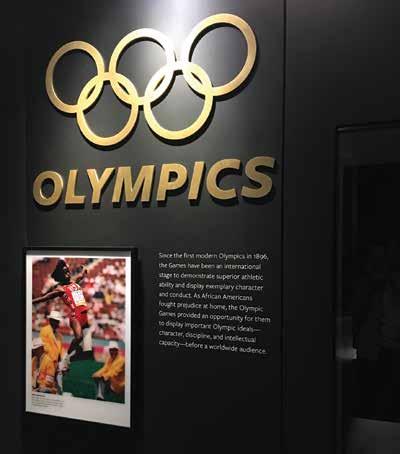
A sports wing at the new Smithsonian museum features six statues, five of which depict U.S. Olympians.
By Scott McDonaldThe National Museum of African American History and Culture came to fruition when it opened in September 2016 in Washington D.C. It only took five decades.
The sports wing isn’t nearly as expansive as those for entertainment, slavery or social injustice, but its importance doesn’t go unnoticed. The sports gallery takes up about one quarter of one floor in the newest museum of the Smithsonian Institution, and Olympians are well represented.
NYU history professor Jeffrey Sammons, who has written extensively about sports in African-American history, said that talks of opening a museum began in the 1970s when he was working on his master’s degree at Tufts University.
“It was a long and difficult struggle to have such a facility, and its realization
is a testament to lots of scholars, in particular to Dr. Lonnie Bunch, the director of the museum,” said Sammons, who has already visited the museum three times.
Sammons said the “Olympic experience” is highlighted in the sports gallery. In all, there are six statues in the sports area, and three of them are directly related to athletes in the Olympic Games.
One statue depicts sprinters Tommie Smith, John Carlos and Peter Norman at the Mexico City 1968 Olympic Games. Americans Smith and Carlos won gold and bronze, respectively, in the 200-meter while Norman, an Australian, won silver. Smith and Carlos gained recognition for each raising a blackgloved fist in a “Black Power” salute during the national anthem, protesting social injustice. Norman, who is white, showed solidarity by wearing a badge supporting the Olympic Project for Human Rights.
Another statue is of track and field star Jesse Owens running at the Berlin 1936 Olympic Games. At those Games,
Owens became a fan favorite while winning gold medals in the 100, 200, 4x100 and long jump, in the process dealing a blow to Adolf Hitler’s efforts to use those Games to prove his ideology of Aryan superiority. However, Owens still faced discrimination and segregation upon returning to the United States.
“We had blacks performing on the world stage unrivaled in the Olympics,” Sammons said. “People made all sorts of propaganda in victories of black athletes. Berlin is often known as Jesse Owens winning four gold medals, but there were other African Americans who performed like Cornelius Johnson and Ralph Metcalfe.”
Johnson won gold in the high jump and Metcalfe won gold on the 4x100 team and silver in the 100 behind Owens. In all, the United States sent 18 black athletes to Berlin.
The third Olympic-specific statue is long track speedskater Shani Davis, who became the first black athlete to win an individual gold medal at the Olympic Winter Games when he won
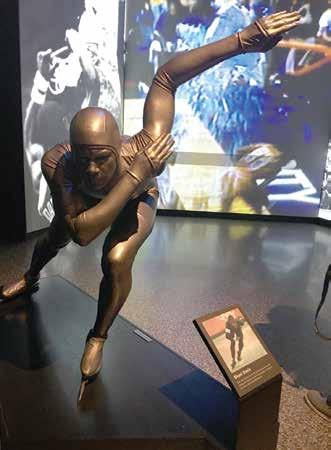
the 1,000-meter in 2006 in Torino. He also won the silver medal in the 1,500 at those Games in Italy and duplicated the feat in both events four years later in Vancouver.
There are also two statues in the museum that depict Olympic athletes but in their sports back home. The Michael Jordan statue shows the twotime Olympic champion’s last shot as a member of the Chicago Bulls, and the Venus and Serena Williams sculpture is of the Olympic champion sisters celebrating a women’s doubles tennis championship.
Jordan won his first Olympic gold medal in 1984 as a college student and then came back to win another with the “Dream Team” in 1992 in Barcelona. The Williams sisters are multi-year Olympians and multiple medal winners, including three times together as doubles partners.
The sixth statue is Jackie Robinson sliding into a base. Robinson broke baseball’s color line when he debuted with the Brooklyn Dodgers in 1947.

Sammons said there are videos to accompany many of the displays that tell the stories of black athletes’ accomplishments in sports. He added that the Olympic experience “is very important to the African-American experience.”
“It is a tribute from the outside into the persistence, and vision, and the struggles of blacks to be recognized and to have their history made available to all who are interested,” Sammons said, “and that includes not just many, many African Americans, but people of all races, ethnicities and nationalities.”
Sammons added that though sports aren’t as important as some of the other major movements in black history, sports still had an integral role.
“What the museum is trying to do, and rather effectively, is position sports in the larger vision of the black struggle with injustice, racism and success,” Sammons said.
“It’s also about bringing these things to life, especially to young people. Anything would be new to a lot of
1. A statue at the National Museum of African American History and Culture depicts Shani Davis, the first black athlete to win an individual gold medal at the Olympic Winter Games.
2. An exhibit at the National Museum of African American History and Culture displays nine of Carl Lewis’ 10 Olympic medals.
visitors. Sport is not something a lot of people see as important to the AfricanAmerican experience other than outstanding performance. Many don’t see how it’s connected to Black Power and international relations in terms of nationalism.”
The museum has proven to be a popular attraction, drawing more than 1 million visitors in its first five months, including a visit from President Trump earlier this month. For Sammons, the end result was worth the wait.
“It’s first-class in every respect,” Sammons said. “It’s on the mall, and it has very fine views of the Washington Monument. One of the problems now is it’s too crowded. But it’s a beautiful facility and a great tribute.”
Scott McDonald has 18 years experience in sports reporting. He was named the State Sports Writer of the Year in 2014 by the Texas High School Coaches Association. McDonald is a freelance contributor to TeamUSA.org on behalf of Red Line Editorial, Inc.
To stay engaged with our bid, sign up for our newsletter at LA24.org, or follow us on the following social media platforms:
Twitter.com/LA2024
Facebook.com/LA2024
Instagram.com/LA2024
YouTube.com/LA2024
Snapchat.com/add/la2024

Hundreds of Angelenos joined LA 2024 for a sunrise celebration at the LA Memorial Coliseum to mark the submission of the bid book to the IOC

More than 60 Olympians and Paralmypians join LA Mayor Eric Garcetti and LA 2024 for the LA City Council’s final vote on LA 2024
Dear Olympians and Paralympians --
Wow! It’s been an action-packed start to the year for the LA 2024 Olympic and Paralympic bid committee. Here’s what we’ve been up to...
First, LA 2024 took center stage at America’s New Year Celebration by partnering with the LA Tourism & Convention Board to produce the City of Los Angeles’ flower-covered “Follow the Sun”-themed float for the annual Rose Parade. I had the great honor of serving as one of the Grand Marshals for the Tournament of Roses alongside Olympic legends and LA 2024 Athletes Advisory Commission leaders Allyson Felix and Greg Louganis. Finally, a long-time dream of mine came true as I tossed the coin to kickoff the Rose Bowl college football game between Penn State and my alma mater, USC!
We at LA 2024 were truly humbled by the more than 500 volunteers who helped decorate L.A.’s “Follow the Sun” float, a tangible reminder that 88% of Angelenos support hosting the Games in 2024. Riding the float were Olympians and Paralympians including American IOC Member Anita DeFrantz, Nadia Comaneci, Bart Conner, Lex Gillette, April Ross, Haley Anderson, Candace Cable, Dawn Harper-Nelson, Holly McPeak, Howard Shu, and Sinjin Smith. They were joined by young Angeleno athletes with the LA84 Foundation, the youth sports non-profit funded by the success of the 1984 Games.
Later in January, we at LA 2024 announced that we were setting our sights on attracting the largest in-stadium, citywide and TV audiences in Olympic Ceremonies history, with a groundbreaking ceremonies concept featuring
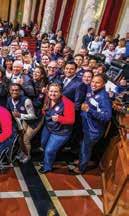

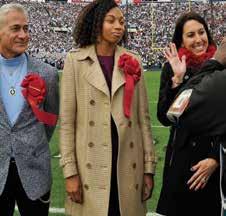

both the LA Memorial Coliseum and the NFL’s new LA Stadium at Hollywood Park.
Using two iconic Los Angeles venues, LA 2024 will create a citywide cultural spectacle combining timeless Olympic traditions and cutting edge entertainment, fitting its ambition to create a New Games for a New Era. One venue represents LA’s fascination with “what’s next,” the other represents the city’s unrivaled Olympic legacy. Together, the stadiums will allow the broadest possible public participation and use LA’s creative talent and technology to unite the world and strengthen the Olympic Movement’s connection to the next generation.
Rounding out the month of January, LA 2024 marked another major milestone when the Los Angeles City Council voted unanimously to give final approval for LA 2024 and authorize the City of Los Angeles to sign the Host City Contract with the International Olympic Committee for the 2024 Olympic and Paralympic Games. We had more than 60 Olympians and Paralympians join us at LA’s City Hall to show support on this historic occasion.
Early February saw LA 2024 deliver our finalized bid book to the IOC. Hundreds of Angelenos joined Olympians, Paralympians and LA 2024 bid leaders in front of the iconic Los Angeles Memorial Coliseum for a sunrise celebration of Olympic spirit, fitness and healthy living, to mark the submission, as well as the start of international promotion in the bid process on February 3.
A few days later, we announced the launch of a first-of-its-kind digitally powered LA 2024 Volunteer Service Program. The Volunteer Service Program aims to harness Angelenos’ passion for the Games and for volunteerism to benefit LA’s communities well before 2024. LA 2024’s Volunteer Service Program will spotlight opportunities in 2017 for Angelenos to make a difference in their communities through volunteer work and community service, providing tangible benefits to the region during the bid phase. In recognition for their service, participants will receive priority consideration for volunteer opportunities during the 2024 Olympic and Paralympic Games, should LA be elected host city by the IOC.
Finally, Angelenos joined LA 2024, Olympians and Paralympians on
February 9 to celebrate the one year mark to the Olympic Winter Games Pyeongchang 2018! In a nod to Angelenos’ excitement for Pyeongchang 2018, but keeping in true LA fashion, the event featured a custom-made 4-lane street curling sheet in the center courtyard of Koreatown’s iconic 1920’s Chapman Market surrounded by local businesses. Attendees participated in street curling, guided by experts from the Hollywood Curling Club and Olympians and Paralympians, and sang their favorite songs at a pop-up karaoke stage.
And now it’s off to the races until the IOC’s final vote in Lima, Peru on September 13, 2017. Thank you, as always, for your support and for following our bid’s progress. I am encouraged every day knowing that we all share the same Olympic and Paralympic dream to give our athletes home Games in 2024!
Follow The Sun, Janet Evans

Youth sports, Olympic legacy, research, exhibitions, civic and thought leadership come together at this extraordinary Los Angeles campus where Olympic athletes are forever welcome.
Last October in Downtown Los Angeles, more than 400 people spontaneously leaped to their feet. Some dabbed tears of joy streaming down their faces. Others pumped fists and hollered. Everybody applauded wildly. What was the occasion of all this positive emotion? Lex Gillette has just finished singing –brilliantly, movingly, a cappella – our national anthem at the fifth annual LA84 Foundation Summit.
Gillette, of course, is a Paralympic star, winner of four medals, and also a sixteen-time national champion who owns the world record in the long jump. And – he can really sing.
The LA84 Foundation is known as the House the Olympics Built. Located on a campus near the University of Southern California, LA84 is headquartered in a pair of buildings, bisected by a courtyard with pomegranate trees and a sculpture featuring Olympic sports pictograms and a flame that burns radiantly as a reminder of the Foundation’s Olympic heritage. The campus was acquired

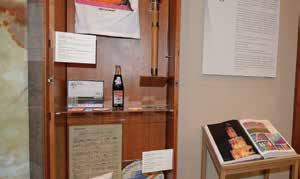
following the 1984 Olympic Games, as LA84 was established with surplus funds from that highly successful Summer Olympics.
More than thirty years later, LA84 is a nationally recognized leader in support of youth sport programs and public education about the role of sports as a tool for positive youth development. Led by President & CEO Renata Simril and a cross-disciplinary staff and under the oversight of a Board of Directors that includes civic, business, and Olympic luminaries such as Peter V. Ueberroth and Rafer Johnson, LA84 has invested approximately $230,000,000 in the community, impacted more than three million kids and their families, trained more than 75,000 coaches, supported more than 2,200 non-profit partners across more than 50 different sports,
and helped build or rebuild more than 100 youth sports facilities.
LA84’s world-class digital library (free to the public at www.la84.org) commissions original research and via its vast collections is a boon to researchers, students, and casual visitors alike – more than four million documents were downloaded last year. LA84 is the lead funder for programs such as the Los Angeles Unified School District’s Beyond the Bell Afterschool Sports Program, which gives every middle school student the chance to play. LA84 levels the playing field so that sport is accessible to all children, while elevating the field of youth sports as an integral part of American life. For more information, please visit www.la84.org and engage with LA84 on Instagram, Twitter, Facebook and LinkedIn.
LA84, with its ample event, meeting and exhibition space, also serves as a convener, bringing leaders of today and tomorrow together to discuss and solve issues related to sports, youth participation, civic engagement and more. In recent months, LA84 has organized and hosted convenings of leaders of skateboarding non-profits, women coaches and golf organizations. LA84’s signature annual convening is that annual Summit where Gillette sang. (The video clip of this impromptu performance had been viewed more than 150,000 times on the LA84 Facebook page, as of this writing.)

A long list of other distinguished Summit speakers ranged from Los Angeles Mayor Eric Garcetti to Chairman of the LA 2024 Bid Committee Casey Wasserman to Olympian swimmers Janet Evans and Gary Hall Jr. Also in attendance –and the subject of sustained applause when introduced – was Anita DeFrantz, member of the International Olympic Committee, and immediate past LA84 Foundation president.
LA84 and LA2024 teamed up last summer, and are partners again this year in hosting Olympic Day. Last year, more than 500 young athletes took part in a ceremony and lighting of the Olympic
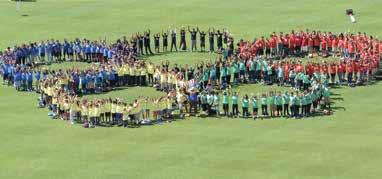
The theme of the Summit was, “PLAYING FORWARD: The Present and Future of Youth Sports.” Taekwondo Olympian Steven Lopez, Olympic fencer Ibtihaj Muhammad and track & field Olympian Barbara Nwaba joined Gillette on a panel emceed and moderated by soccer Olympian Julie Foudy.
The quintet – who collectively have won fifteen medals competing for the United States – shared their personal journeys towards the Olympics and Paralympics, and what playing sports meant to them growing up. “As an athlete that benefited from sport through a nonprofit, I recognize that the LA84 Foundation has such a vast reach and positive impact on our youth,” Muhammad said, similar to what a stream of Olympians such as Tony Azevedo (water polo) and Kerri Walsh Jennings (volleyball) have previously said.
flame inside the Los Angeles Memorial Coliseum, the main site of the 1932 and 1984 Olympic Games. Youth from across the city took part in nine Olympic and Paralympic sports – archery, badminton, fencing, gymnastics, rowing, rugby, soccer, volleyball and Paralympic sitting volleyball – while learning from Olympians, LA84 grantee programs, and local sport and adaptive programs. “These youth can take the experiences and lessons of Olympic Day to empower themselves in all their endeavors,” said Simril, the LA84 President and CEO. “The spirit of the Olympic and Paralympic Games and the values they instill have provided countless young Americans with lifelong growth through the power of play, and this event continues that tradition.”
LA84 keeps that tradition going in many other ways, as well. LA84 curates and
displays exhibitions of Olympic heritage. Some of these shows have traveled, others are site-specific to LA84. Currently on view is, “Los Angeles: The Olympic City,” featuring medals, trophies, photographs and other artifacts highlighting the rich Olympic heritage of this two-time Olympic city, and its bid for a third. The exhibition also includes torches and memorabilia from other Summer and Winter Games, displaying the foundation’s wide-ranging Olympic archives.
Readers of this publication are cordially invited to visit LA84 and see the show. Olympians have a standing invitation to come and use the LA84 space – whether relaxing on couches and chairs in the group’s Olympian Lounge, using wi-fi, doing research, etc. On a related note, LA84 is now the home of the Southern California Olympians & Paralympians (SCOP). To celebrate this arrangement, LA84, SCOP and LA2024 co-hosted a “Welcome Home from Rio” reception for athletes who participated in the Rio Olympic Games. Also on hand were members of the LA84 SAMbassadors – Student Athletes in Motion – youth advisory group, the voices of tomorrow who engage and advise LA84 on its work. The SAMbassadors take their name as well from beloved 1984 Olympics mascot, Sam The Eagle. “We are delighted to partner with the LA84 Foundation,” said SCOP President Tamara Jenkins. “We are the largest and oldest Olympic alumni group in the county and it’s fitting that we will be located at the foundation which is the legacy of the 1984 Olympic Games.”
“The LA84 Foundation is happy to welcome SCOP closer into our work,” said LA84’s Simril. “LA84 and SCOP will collaborate to promote Olympic values and heritage and to help LA84 continue to inspire the next generation of leaders and Olympic athletes.”

It’s January 1937. Baron Pierre de Coubertin has just turned 74. He’s broke, his health is failing, and although he has created one of the most influential international movements of the 20th century, he is completely unknown outside a small circle of admirers. Angry at their losses, his wife can hardly withhold her bitter animosity, his son is tragically impaired, his daughter is battling mental illness, and his great creation is about to fall into the hands of a Nazi madman leading the world to war. Hope arrives when a new ally appears. Jacques St. Clair from Le Petit Journal in Paris, the world’s leading Olympic sportswriter, moves to Lausanne with his American fiancé, the painter Juliette Franklin, to spend a year writing the baron’s biography. Once St. Clair begins the interviews, Coubertin is rejuvenated as his story unfolds in scenes that flash back through the past seven decades. The young couple becomes fully immersed in Coubertin’s life—as Juliette begins to paint the baron’s portrait— and both are deeply affected as his health declines and the race to finish the interviews faces an increasingly impossible deadline.
The Idealist is a vivid portrait of an extraordinary man set against the backdrop of transformation that gave us the splendors of Paris in the luminous years of the Belle Époque. Hirthler’s meticulously researched writing evokes a vivid historical panorama of the birth of the modern Olympic Movement
through the eyes of the man who made it happen. In the pages of this novel, we are transported to the front rows of history and immersed in the untold story of Coubertin’s unrelenting drive to create our world’s greatest celebration of humanity.
Author Profile:
George Hirthler is one of the leading creative talents at work in the Olympic Movement today. A writer/producer, Hirthler is a seasoned campaign director who has served as chief communications strategist for ten international Olympic bid campaigns, including the winning bids of Atlanta 1996, Beijing 2008 and Vancouver 2010.
Through two decades of Olympic research, Hirthler became increasingly interested in the life of Baron Pierre de Coubertin, and increasingly astonished that this remarkable man was so widely unknown. In 1996, the Republic of France awarded Hirthler the title of Chevalier in the Order of Arts and Letters for his work in promoting the Olympic Ideal and the legacy of Baron Pierre de Coubertin.
In 2004, Sports Business Journal named Hirthler one of the 20 Most Influential People in the Olympic Movement for his work on bids. In 2011, Hirthler turned his attention to historical fiction and four and a half-years later, finished The Idealist, the first major novel on the life and times of the founder of the modern Olympic Games.
A graduate of Temple University’s School of Theatre and Communications, Hirthler lives in Atlanta with his wife, Carole.
At the 1968 Mexico City Games, as a member of Team USA, I experienced the extraordinary promise of the world coming together in friendship and peace through sport. Right after the Games, I went to Vietnam—and the contrast and conflicts I experienced there left me wondering why more people didn’t embrace the Olympic ideal and its full promise for our world. I’ve long wondered—as so many Olympians have—how this marvelous movement got its start and why we don’t know more about its origin story.
George Hirthler’s book, The Idealist, helps to answer these questions and many more, by telling the story of Baron Pierre de Coubertin in a thoroughly engaging manner. In the early 1890s, de Coubertin experienced a calling that he could not ignore, but one that he could not fully articulate at first. The passion he felt propelled him along an inexorable trajectory, one that contained challenges, tragedies, setbacks, and heartaches, but ultimately a magnificent triumph in 1896—the establishment of the modern Olympic Games.
Hirthler’s story of de Coubertin resonated strongly with me, in part because I have experienced an Olympic environment first-hand. However, I believe that it will also resonate with others as well. If you have any interest whatever in the modern Olympic movement, you owe it to yourself to read this book.
Tom Lough 1968 U.S. Olympic Team Modern Pentathlon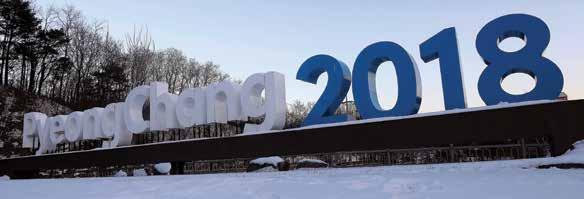
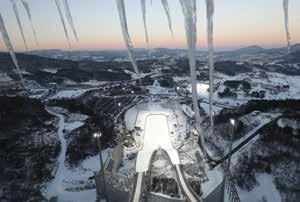
With one year to go to PyeongChang 2018, the World Olympians Association (WOA) is stepping up its planning for the XXIII Olympic Winter Games, looking at ways to enhance the experience of Olympians returning to the Games.
As part of its preparations WOA is developing ideas for a range of networking activities and events, as well as the return of its popular ticketing programme, for the benefit of Olympians of all ages, nations and sports who will be in PyeongChang for the Olympic Games. WOA is aiming to build on the huge success of its award-winning Olympians Reunion Centre in Rio, and learnings taken from its activities at Sochi 2014, in order to better serve the needs of Olympians who are in PyeongChang to watch or take part behind the scenes.
As tens of thousands of athletes dedicate themselves to training and qualifying for PyeongChang 2018 many more Olympians will be working hard in the background to make the event a success, with roles within the organising committee, as ambassadors, coaches or with NOCs, the IOC, International Federations .and other Olympic Family members.
WOA’s aim is to serve the needs to those returning Olympians, giving them an opportunity to come together with other Olympians in the unique setting of the Games to share stories and experiences, meet new friends and past acquaintances.
“One year to go is an exciting time for the athletes as they step up their preparations for the Games, which for many will represent the pinnacle of their sporting careers”, said WOA president Joël Bouzou.
“PyeongChang 2018 is shaping up to be a fantastic celebration of sport and Olympism and we are excited to welcome all the new Olympians who will make their Olympic debut. We also look forward to serving the needs of Olympians returning to the Games as spectators or in an official capacity by
building on the great success of our Olympians Reunion Centre in Rio and our Olympians programmes and events at the last Winter Games in Sochi and can’t wait to share further details about our plans for PyeongChang later in the year.”
WOA ExCo Member, three-time U.S. Olympian in the triple jump, Willie Banks, said:
“The Olympians Reunion Centre at Rio 2016 was hugely valuable as it gathered Olympians from around the world together to share ideas and experiences and look at ways we can continue to support the Olympic Movement and spread the Olympic values in our own countries and communities. In PyeongChang, WOA will again be providing unique and interesting experiences and events for Olympians who are visiting the Games either a spectators or as part of their post-athletic career.”
For more information on the WOA programme for PyeongChang 2018 or to get involved please contact info@thewoa.org.

As the archivist for the Crawford Family U.S. Olympic Archives and historic steward for the U.S. Olympic Committee, I could not be more excited about the forthcoming U.S. Olympic Museum (USOM). We are elated to bring to life the history of the U.S. Olympic and Paralympic Movement in the United States using interactive displays and historic artifacts to all Americans as well as the world. The Crawford Family U.S. Olympic Archives has worked closely with the U.S. Olympic Museum consultants in the early phases of the Museum’s design and now we are assisting further in this next phase of capturing and presenting the history of our Olympic and Paralympic athletes. Without divulging the cutting edge
designs of Barrie Projects, the Museum Content & Development team and Gallagher & Associates, the exhibit designers for the U.S. Olympic Museum, it is time to begin the quest for specific items connected to your unique history as Olympians and Paralympians. The call for photographs, artifacts, uniforms, etc. will be accomplished in phases as the USOM team moves through their designs, with deadlines for each phase to facilitate the Museum’s design schedule. With that stated, it is time for phase one to begin!
Phase One of the Call to Arms to our Olympic and Paralympic athletes involves photographs. The U.S. Olympic Museum needs images of
you as youths competing or leading up your Olympic and Paralympic careers. They are specifically asking for family photographs of you in your first skating costumes, wearing your first pee wee hockey uniforms, competing in youth league soccer games, running in school track meets, or standing next to the first horse you rode, as well as moments in between those firsts and your final Olympic or Paralympic experiences. Once all have been gathered, the USOM team of exhibit professionals will select the photographs to be used in the initial U.S. Olympic Museum exhibits.
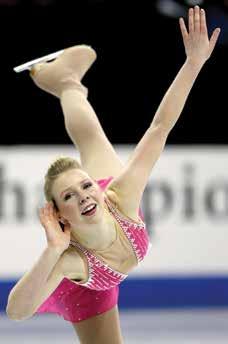
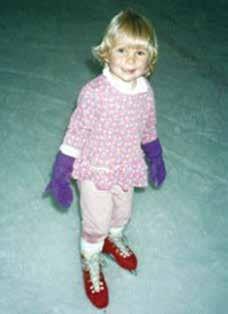
In order to facilitate the design implementation, and to make sure the images are available for use, there are a few requirements that must be met before sending any photographs in for selection:
1. Prefer images of you as children/ young adults competing in your sport or of you in your previous life prior to your Olympic/Paralympic experience.
2. Prefer images only of yourself.
3. Prefer family photos or must know the name, and have approval of the photographer for possible use in Olympic Museum – if the name of the photographer is not known, the image may not be considered.
4. Photographs must be identified with your name and approximate date of photograph [Please do not write on the back of the photograph! This often damages the original image]
5. We prefer original photographs.
6. If sending digital images – they must be at 300dpi or higher. Taking a photo of the original with your smart phone will not give us a high enough resolution to use the image.
7. Enclose a typed-written description of the image, i.e. JaneSmith,age9, competinginWinnemuccayouthtrail races. Takebymom,MaryJaneSmithin 1975.
This is an exciting time for the Museum! Exhibit designs have been approved and now, with your help, the U.S. Olympic Museum will come to life. It will tell your story, relate your trials and triumphs and trace your history as you become U.S. Olympians and Paralympians. Please share this information with your teammates and Olympian or Paralympian friends as well. Remember, requesting your photographs is only the first phase. Stay tuned for the next Call to Arms and assist the U.S. Olympic Museum in becoming the premier Olympic Museum in the world.
Now that you are ready to dig into your photo albums or call your mom for those photographs here is the address where to send them:
CARE OF:
TERI HEDGPETH CRAWFORD FAMILY U.S. OLYMPIC ARCHIVES
U.S. OLYMPIC COMMITTEE
1 OLYMPIC PLAZA
COLORADO SPRINGS, CO 80909
If you have any questions regarding this project, please feel free to reach out to me at teresa.hedgpeth@ usoc.org or check out the U.S. Olympic Museum’s website at www.usolympicmuseum.org
Rachael Flatt, 1996. First time on skates.
Photograph
8. Cut-off date to send images is July 31, 2017. This is the last date to send images to the Museum team.

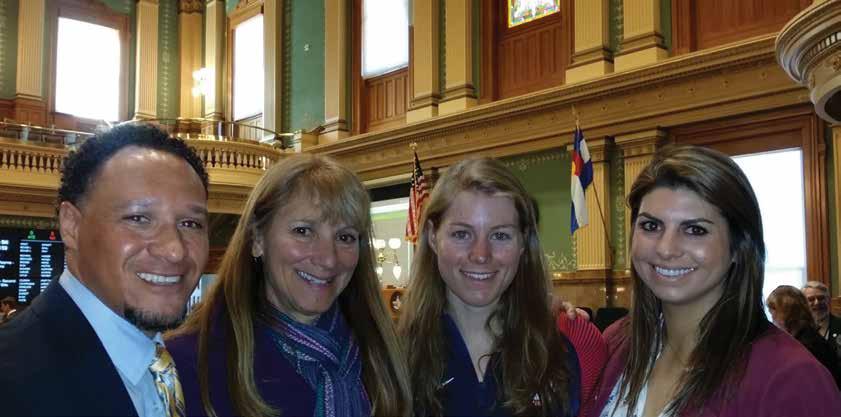
Any accomplished athlete can testify to the need to reflect on the previous year’s accomplishments and lessons learned to better plan goals and strive for success in the coming months.
The U.S. Olympic Committee’s Athlete Career and Education (ACE) Program is no different. Led by Olympian Leslie Klein, the ACE team added a number of “W’s” to the win column in 2016.
Highlighted by hosting the Olympic and Paralympic Summit for 212 Team USA Olympians and Paralympians following the Games in Rio, and the launch of the Pivot Workshop addressing the mental challenges athletes face when navigating life after competitive sport, the ACE program relished tremendous success in 2016.
Entering 2017, the ACE program has grown to serve over 1,100 Team USA athletes across 85% Olympic and Paralympic sports. In order to meet
the variety of needs from active and retired athletes, ACE expanded its collection of services to include a diverse array of resources, workshops and additional staff. Career services remains at the core of the program, enabling active athletes to find parttime employment and professional development opportunities, along with providing retiring athletes with the needed assistance to discover full-time career options. Through résumé and interview prep, one-on-one guidance from career coaches and a growing list of employers seeking talent with the unique transferrable skills that make Team USA athletes successful, ACE placed nearly 150 athletes in jobs in 2016.
To better the connections between athletes and ACE coaches while capitalizing on relationships with employers, ACE launched a new
online platform with a “LinkedIn meets Facebook” interface. The customized platform provides a more attractive and functional resource tool, while inviting athletes, employers and ACE staff to interact in a new online community. With access to over 10,000 jobs from athlete-friendly employers at all experience levels and more than 200 recruiters with Fortune 500 companies; the ACE platform will continue to be a robust career search resource for all Team USA athletes regardless of their current career aspirations.
Along with job resources, the ACE platform will serve as home to education opportunities, highlighted by DeVry University. The school renewed the sponsorship with Team USA, doubling its contribution to athlete education over the next four years. ACE has earmarked funds for Olympic and Paralympic
alumni who seek to complete their undergraduate education or pursue an MBA through the Keller Graduate School of Management. Scholarship applications open every other month and details can be found by registering and utilizing the ACE platform at www. TeamUSA.org/ACE.
The ACE program is pushing the idea of a Team USA community by leveraging the new platform to connect U.S. Olympians & Paralympians Association alumni with athletes through mentorship. The ACE Mentor Network pairs athletes with alumni, Games medalists and business professionals for one-on-one video/ phone sessions. In a controlled, 30-minute conversation, athletes can seek advice on topics such as handling the Games environment, managing the stresses of their first Games, coping with retirement, finding sponsors, planning for another four-year Games run, maintaining personal relationships while being an athlete, and more. To learn how you can contribute to Team USA success by candidly sharing your knowledge and experience with athletes, contact ace@usoc.org.
While career and professional development services stand as a pillar of the ACE program, 2016 was highlighted by ACE events. The Olympic and Paralympic Summit presented by the Foundation for Global
Sports Development played host to 212 Rio Olympians and Paralympians immediately following Team USA’s visit with President Obama at the White House. The Summit, a three-day event providing athletes with tangible insights and actionable resources for career and life, featured the inaugural USOPA Induction Ceremony led by Joey Cheek, an LA 2024 Town Hall hosted by Janet Evans, athlete panels, workshops and a networking reception with alumni and business professionals. Athletes were also gifted a quote book entitled Passing the Torch: U.S. Olympians and Paralympians Share their Journey to “Life Beyond Sport”
In addition to the Summit, ACE launched Pivot, a workshop aimed at empowering retiring athletes with a variety of tools to help maximize their performance as they pivot from competitive sport into the next passion in their lives. Facilitated by sport psychologists and USOPA alumni, the two-day workshop and monthly online group meet-up actively assists with the mental and emotional challenges facing athletes when they walk away from the playing field. Athletes are reporting feeling more hopeful for the future and confident in approaching education and career opportunities.
After a successful 2016, ACE will continue to push the standard of excellence by growing the Pivot
program, bringing additional education and career resources to the ACE platform and exploring development of programs for public speaking, brand management and mental health. The ACE team is already closing in on an early win, working with officials from the University of Colorado education system and state legislators to push forward a bill expanding in-state tuition benefits to Team USA athletes who live/train in Colorado but are originally out-of-state residents. The bill will, hopefully, incentivize more athletes to go to school while training. Finally, the ACE team added two new members: Athlete Career Coach, Megan Psyllos; and Business Operations Coordinator, Lucky Byas. Psyllos, a former Division-1 field hockey athlete at the University of California Berkeley, will focus on assisting athletes with education opportunities. Byas, a recent graduate of Trinity University where she was awarded Outstanding Senior in Sport Management, will assist with helping the team run more effectively through her expertise in data analytics.
ACE is excited to continue to support Team USA athletes on and off the playing field by providing and growing career, education and life skills resources aimed at driving both performance and professional development.

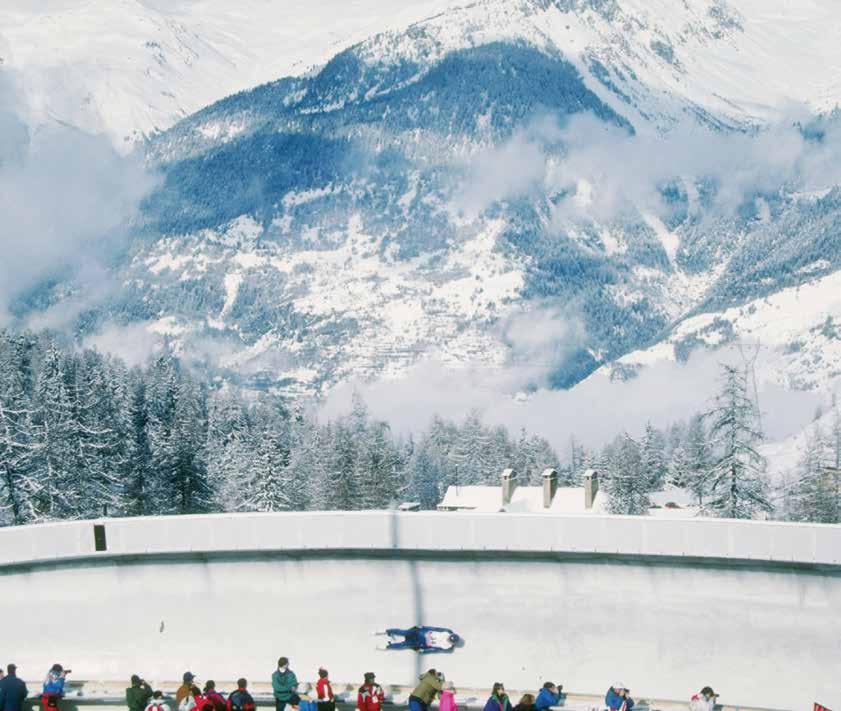
Twenty-five years ago, a small town in the Savoy Alps of France captured the attention of the sports world. The Albertville 1992 Olympic Winter Games opened Feb. 8, 1992, and closed 15 days later.
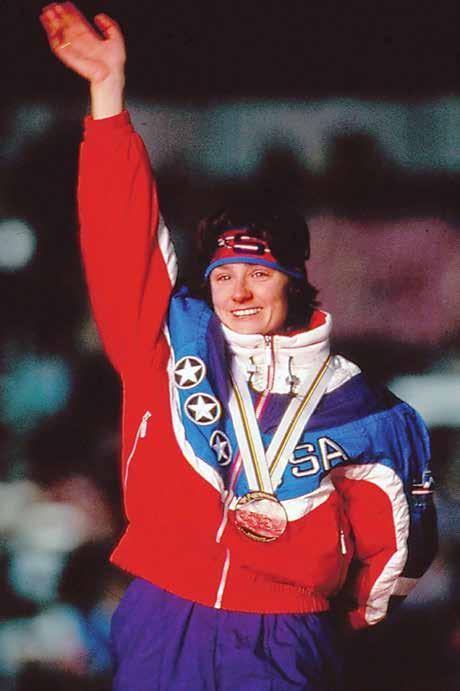
Team USA won 11 medals, nearly doubling its medal haul from 1988. Women accounted for nine of those
medals, with Bonnie Blair racing to two speedskating golds on the outdoor oval, Kristi Yamaguchi gliding to victory in figure skating, Donna Weinbrecht powering to the inaugural gold in moguls and Cathy Turner earning the first short track speedskating title for the United States.

Here are 10 memorable Team USA moments from those Games, the last Winter Games to be held in the same year as the summer edition.
Long Track Speedskating
Feb. 10, 1992
The speedskater from Champaign, Illinois, went into Albertville with great fanfare. She was the only American woman to win a gold medal four years earlier in Calgary – claiming victory in the 500-meter – as well as the only Team USA athlete to take home two medals after skating to bronze in the 1,000.
Blair also had personal goals, dedicating the Olympic Games to her father Charlie, who died on Christmas Day, 1989.
Blair was supported by nearly 50 members of “The Blair Bunch,” the family and friends in purple coats who traveled to Albertville and serenaded her with “My Bonnie Lies Over the Ocean.”
Blair won with a time of 40.33 seconds to become the first U.S. woman to win a gold medal in two different Winter Games. Ye Quiabo of China, who had skated three pairs before Blair, placed second in 40.51.
“I know I couldn’t have done any better on this day,” Blair said.
Two years later, however, Blair outdid herself by winning a record third straight title in the 500 in Lillehammer.
Long Track Speedskating
Feb. 14, 1992
On Valentine’s Day, it was time to fall in love with Blair all over again. Two
days earlier, she had placed 21st in the 1,500-meter, but that was only after coasting the final 400 meters when she realized she was not in medal contention.
In the 1,000, Blair skated before her main rivals. She had a strong start and clocked 1 minute, 21.90 seconds. Then she had to wait. Ye and Monique Garbrecht of Germany went headto-head three pairs after Blair’s race. Ye’s time was 1:21.92, two-hundredths slower than Blair, while Garbrecht came in at 1:22.10.
Blair went on to win the 1,000 in Lillehammer for a record sixth medal by a U.S. winter athlete, male or female. She was also the first U.S. woman to win five gold medals at either the winter or summer edition of the Games.
Figure Skating
Feb. 21, 1992
As a little girl, Kristi Yamaguchi’s favorite toy was a Dorothy Hamill doll. When Yamaguchi, the reigning world champion, skated onto the ice in Albertville, no American woman had won a gold medal in women’s figure skating since Hamill in 1976. However, Midori Ito of Japan, the 1989 world champ and the first woman to land a triple axel, was the favorite.
Yamaguchi, a California native, led after a lovely “Blue Danube” waltz original program, with her Olympic roommate, Nancy Kerrigan of Massachusetts, in second place. Ito fell in the original program, but was still in the hunt for a medal.
Yamaguchi – her performance skating to “Malagueña” was good enough for gold.
Ito was the first woman to land a triple axel in Olympic competition and won the silver medal while Kerrigan earned the bronze, marking the first time since 1960 that Team USA won two medals in the event. The third U.S. competitor, Tonya Harding, was fourth.
Freestyle Skiing
Feb. 13, 1992
Freestyle skiing made its debut in Albertville, with moguls – known as “bumps and jumps” – taking place in Tignes. Weinbrecht, the 1991 world champion from New Jersey, came in as the heavy favorite. However, Weinbrecht qualified second behind local favorite Raphaelle Monod of France. In the final, Weinbrecht skied to the accompaniment of “Rock ‘n’ Roll High School” by the Ramones, completing a run that was conservative, yet clean. She scored 23.69 points to edge Yelizaveta Kozhevnikova of the Unified Team (23.50), but had to wait for Monod, who was the eighth and final competitor. Monod encountered trouble and came in last, to the dismay of 20,000 fans.
“It was like a concert, and you’re on stage,” Weinbrecht later told the L.A. Times. “It was hard to fathom that all those people were looking at you and screaming.”
Prior to the long program, Hamill sought out Yamaguchi backstage to wish her luck. Although none of the top women skated a clean long program – not even
Weinbrecht suffered a knee injury the next season and had surgery, then went on to dominate the 199394 world cup season. However, she was a disappointing seventh at the Lillehammer Games. Weinbrecht competed again in 1998 in Nagano, placing just off the podium in fourth.
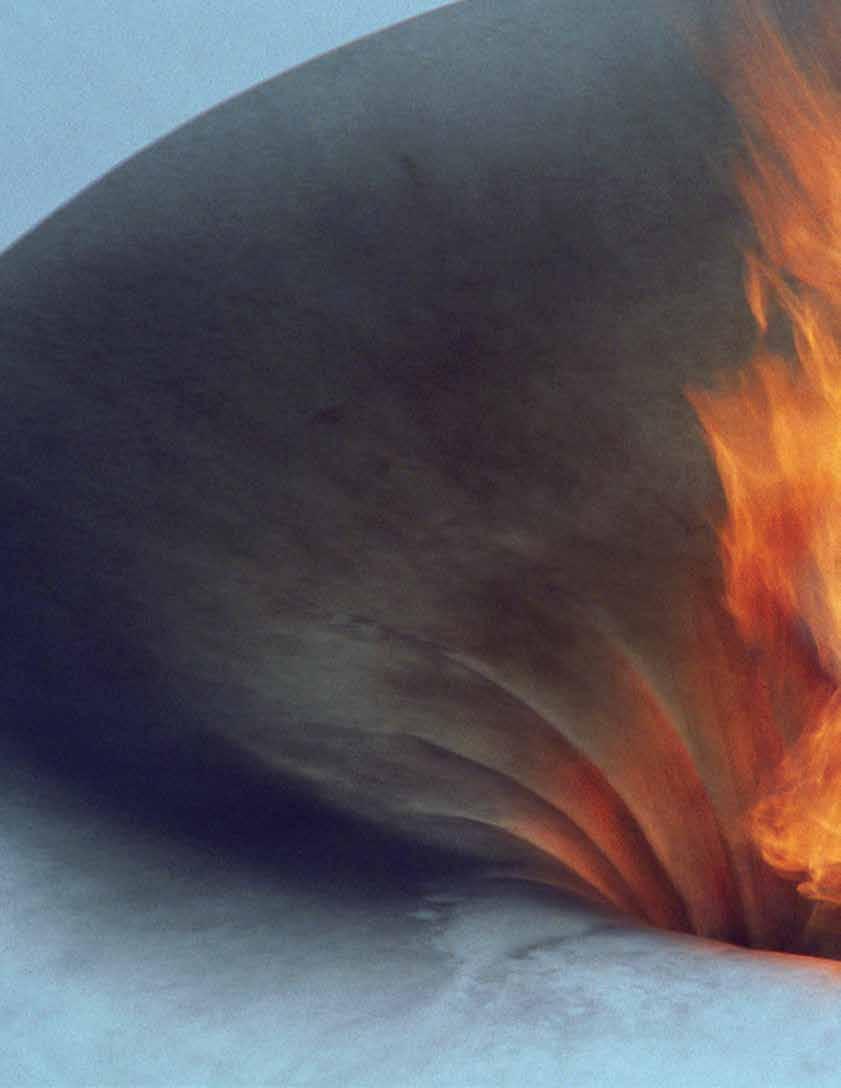
Feb. 22, 1992
After missing a spot on the 1980 Olympic team, Turner retired from speedskating and became a singer/songwriter.
She returned to the sport in 1988 and made world teams in 1989, 1990 and 1991. Known for her scrappiness, the New York native was a natural in short track. In the 500-meter final, she was in the lead when Chinese skater Li Yan clipped her skate on the homestretch. Turner threw her skate forward at the finish line and won, edging Li by .04 with a time of 47.04.
Turner retired from competition after the Games, briefly joining the Ice Capades, then returned to defend her title in 1994 in a controversial finish. She again retired, returning once more to make the 1998 Olympic team at age 35.
Alpine Skiing
Feb. 15, 1992
Team USA was shut out of the medals in alpine skiing at the Calgary 1988 Games. With the downhill course at Meribel considered the most difficult women’s course of all time, only 0.18 of a second would separate first place from fifth.
Kerrin Lee-Gartner of Canada was the unexpected winner of the gold while Lindh became the surprise silver medalist. World champion Petra Kronberger of Austria won the bronze.
Lindh, a native of Alaska, had previously placed no higher than sixth in a major international race, although she was the first American to become world junior champ in downhill. At the Calgary 1988
Games, she missed a gate and did not finish the downhill race.
Lindh also had taken only one training run on the long, fast track at Meribel since the U.S. team was forced to leave a training camp early the previous season because of the Gulf War.
After winning her silver medal, Lindh said, “No matter what happens after this, I’ve always got this.”
She went on to win a bronze medal at the 1996 world championships in downhill, followed by the world championships gold a year later in Sestriere, Italy.
Alpine Skiing
Feb. 19, 1992
At age 17, Roffe burst on the international scene to win the 1985 world title in giant slalom. After a world cup victory that same season, Roffe went through a seven-year drought.
An injury ended Roffe’s 1991 season, but she had a strong start to the Olympic year.
Then Roffe almost fell at the top of the first run in the giant slalom, placing ninth, with teammates Julie Parisien, skiing with a broken wrist, in fifth and Eva Twardokens sixth.
Roffe feared she had given up too much time. As the first American to tackle the second run, she skied with “nothing to lose,” she said, and posted a tremendous performance.
Pernilla Wiberg of Sweden clocked 2:12.74 to win the gold while Roffe and Anita Wachter of Austria wound up tied for the silver medal with a time of 2:13.71. Parisien was fifth and Twardokens seventh.
“I knew it was in me to do this,” Roffe said. “After all the down times, I’m back. It’s everyone’s dream to win an Olympic medal.”
Roffe, a native New Yorker, had trouble adapting to the shape and size of the next generation of skis, and barely made the 1994 Olympic team. She was the first skier down the slope in Kvitfjell, the Lillehammer venue, in the super-G, but her time held up for the gold medal.
Roffe followed that with her first world cup title in nine years, winning the super-G at Vail to end her career on a high note.
Figure Skating
Feb. 15, 1992
Wylie was not considered a medal contender in Albertville. His previous highest finish in an international competition had been ninth. At the 1988 Games, he was 10th, and Wylie had to rally to place 11th at the 1991 world championships.
The 27-year-old Harvard graduate had never even won the U.S. national title, placing second in the competition to determine the 1992 Olympic team behind Christopher Bowman.
And yet Wylie was masterful in Albertville and won the silver. Skating to “Henry V,” he was the only athlete among the top six who did not fall or touch the ice with his hand in the long program. Viktor Petrenko of the Unified Team had more challenging elements and won the gold medal, though two judges placed Wylie first in the long program.
Bowman was fourth, pulling himself up from seventh after the original program.
“I always wanted to skate well in the Olympics,” said Wylie, who was third
in the original program. “I wanted to be able to say, ‘Yeah, that was great. That was my moment.’ It’s the happiest moment of my life.”
A reporter pointed out that he could have won the gold.
“Hey,” Wylie said, “how much of a Cinderella story do you guys want?”
Feb. 20, 1992
In an event that was supposed to be a showdown between Canada and China, the Chinese team crashed in their semifinal while on world-record pace. In the final, Canada, which had won six straight world championships, held off the U.S. team of Darcie Dohnal,
Amy Peterson, Turner and Nicole Ziegelmeyer, which earned silver. Peterson, Turner and Ziegelmeyer joined Karen Cashman in 1994 to win the bronze medal in the relay, while Peterson also won the bronze medal in the 500 behind Turner’s gold in Lillehammer.
Feb. 23, 1992
When Carmichael was in high school, his mother was cleaning his room when she found a note he had written. It said, “I want to be among the top five skiers in the world.”
The Colorado native accomplished his goal, winning the bronze medal in moguls to become the first American male skier to win a freestyle skiing
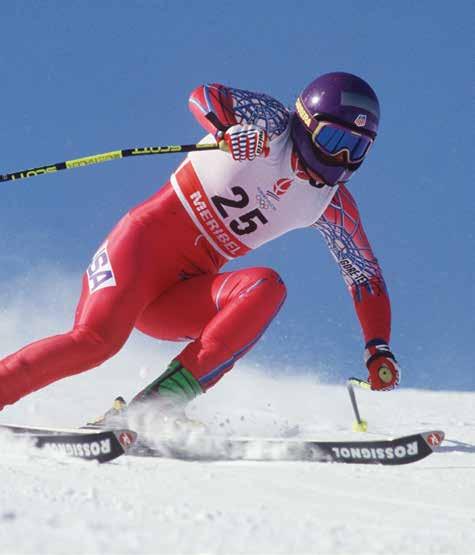
medal. A two-time world cup champion in 1988 and 1989, Carmichael appeared in the Calgary Games when moguls was a demonstration sport, but finished 10th.
In Albertville, on the course in Tignes, Carmichael was in fourth place after the qualifying round. In the final, he moved up to make the podium.
“This medal makes up for ’88,” said Carmichael, who retired after the 1992 season. “I’ve been waiting a long time for this year, and now that it’s finally come, I’m happy.”
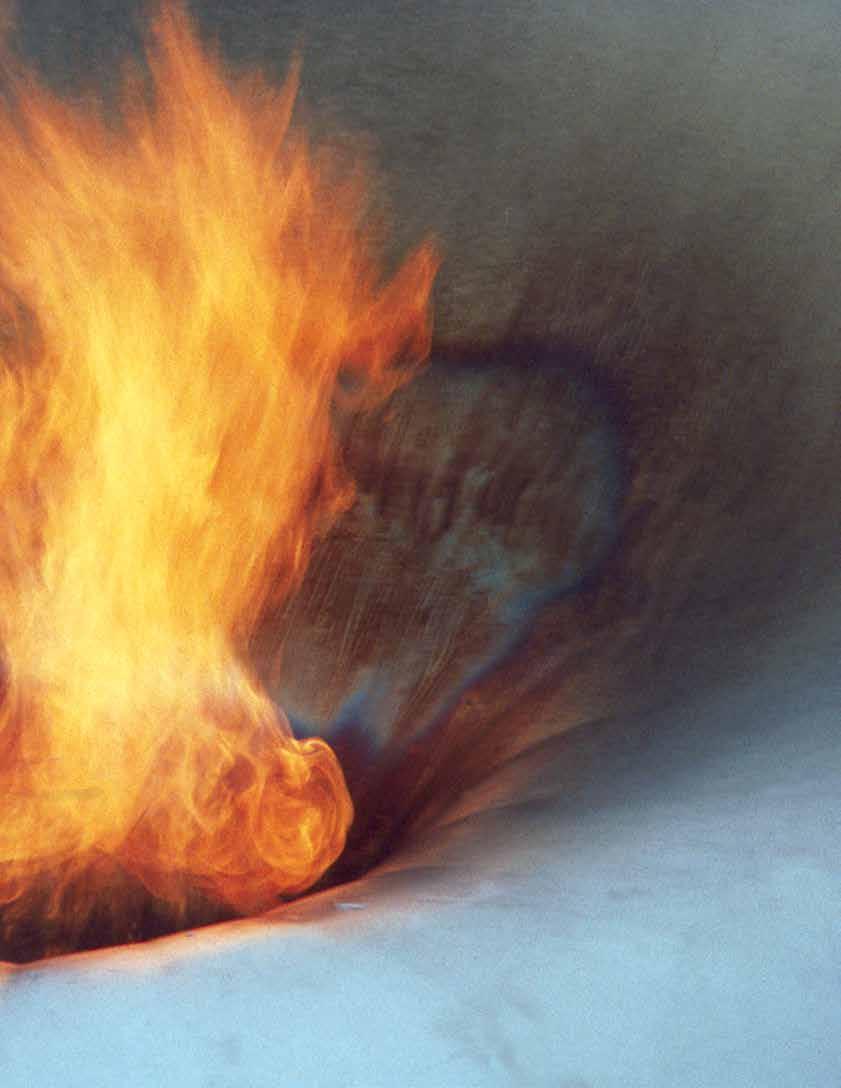
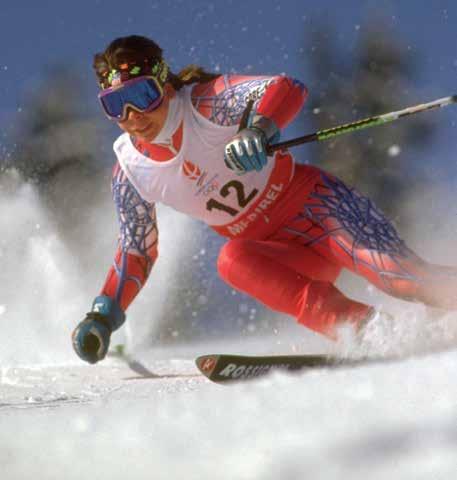
Swimming Hall of Fame as the Class of 2017. Wilkinson is the eleventh individual to be named for ceremonies to be held August 25-27, in Fort Lauderdale. Previously, Open water swimmer Maarten Van Der Weijden, swimmers Wu

The International Swimming Hall of Fame (ISHOF) announced that American diver, LAURA WILKINSON, will become one of seventeen (17) honorees to enter the International
Chuanyu (CHN) and Takeshi “Halo”Hirose (USA), Georges Vallerey, Jr. (FRA), Alain Bernard (FRA), diver Zhang Xiuwei (CHN), long distance swimmer Walter Poenisch (USA), water polo player Osvaldo Codaro (ARG), coach Dick Jochums (USA) and photojournalist Heinz Kluetmeier have been announced.
Beginning with her gold medal in the 10m platform event at the 1998 Goodwill Games, Laura Wilkinson is one of the few divers in the world to claim individual gold medals at every major international diving competition during her career. In addition to winning the Goodwill Games, she won gold medals at the Olympic Games (2000), the FINA World Cup (2004) and the FINA World
Laura Ann Wilkinson was born on November 17, 1977 in Houston, Texas.
Inspired by the publicity surrounding Romanian gymnastic guru Béla Károlyi’s arrival to that city, in 1981, Laura fell in love with gymnastics dreamed of being in the 1996 Olympic Games. But after years of training her gymnastic career ended when a growth spurt during puberty made her too tall for the sport. Then, one day while at a swimming pool, she discovered another sport after seeing an exgymnast friend who had switched to diving execute an impressive dive. In spite of being told by one of her teachers that she was too old to start a new sport, at the age of 15, Laura plunged into diving anyway. She joined a local club and says she “fell in love with the sport on the first day.”
She didn’t go very far her first year, but the next year Wilkinson won her first U.S. National Title, made the U.S. National Team, and earned a bronze medal at the FINA World Cup in the 10m synchronized diving event, with partner Patty Armstrong. Earning a scholarship to the University of Texas Wilkinson won the NCAA 10m platform title in 1997 and 1999 and then gave up her scholarship to turn pro and train for the 2000 Olympic Games, at the Woodlands, with coach Kenny Armstrong.
Three months before the Olympic trials, she was doing a typical warmup, flip, somersault, when she landed on a block of wood and broke her right foot in three places. To fix it, doctors had to re-break everything and they also found she had stress fracture on her left foot as well. It appeared that another Olympic dream was at an end. But with a persevering heart and faith, she was not deterred by this injury. In fact, it may have helped her focus. Together, with her coach, Wilkinson embarked on a brutal training regime that included standing in a cast for six hours a day on top of the platform to practice her push-offs. As soon as the cast was removed, Wilkinson began practicing dives underwater, to avoid putting pressure on her foot. She also watched an insane amount of video tape and visualized every dive to keep her head in the game.
Although her foot was still not fully recovered when she started to train again three weeks before the trials, her perseverance paid off as she won the trials and qualified for her first Olympic Team.
Three months later, while wearing a protective shoe that enabled her to walk up the ladder to the platform, Wilkinson battled back from eighth place and a 60-point deficit after the semifinals to record one of the biggest upsets in Olympic diving history. The turning point came in the third dive
of the final round, a reverse two-anda-half somersault, which Wilkinson performed perfectly, entering the water knife straight with barely a ripple. She went on to win over the favored Chinese diver, Li Na by a minuscule 1.7 points. Her win was the first in the 10m platform event by an American since Leslie Bush, in 1964 and the accomplishment earned her an appearance on a Wheaties’ cereal box and a finalist for the prestigious Sullivan Award as one of the nation’s outstanding athletes.
In 2004, although Laura won the World Cup she finished a disappointing fifth at the Olympic Games in Athens. But she came back the next year to win the gold medal at the FINA World Championships in Montreal. She retired after competing in her third Olympic Games in Beijing as 14 time U.S. National Teams (1995 - 2008), a 19 -time U.S. National Champion and one of the greatest divers of all time.
Today, Laura continues to follow her faith, is a devoted wife and mother, motivational speaker, writer, mentor and encourager. Her passion shines through her speaking as she takes her audience on a leap of faith. The lessons she has learned throughout the peaks and valleys of her diving career have given her an insightful outlook on life and have taught her how to be successful in and out of the pool.
Jim Morris and Donna de Varona honored at United States Olympic Endowment Luncheon

The United States Olympic Endowment presented two awards at its annual luncheon in New York. Jim Morris, vice chairman of Pacers Sports & Entertainment, and Donna de Varona, a two-time Olympic gold medalist in swimming and member of the IOC Women and Sport Commission, were honored in recognition of their commitment and contributions to the Olympic and Paralympic movements.
A long-time community leader, Morris
was named the recipient of the George M. Steinbrenner III Sport Leadership Award. The award is presented annually to honor outstanding members of the Olympic and Paralympic family who have contributed to sport through management, sport organization endeavors or the enhancement of competitive opportunities, and who have displayed qualities of leadership, ethical conduct and dedicated responsibility during a longstanding commitment to sport.
A two-time Olympian and Emmy award-winning journalist, de Varona was recognized with the William E. Simon Award, given to an individual or group who has made extraordinary contributions to the advancement of the Olympic and Paralympic movements.
Simon – the award’s namesake – was president of the USOC from 1981-85 and served as secretary of the treasury for three years under Presidents Richard Nixon and Gerald Ford.
The USOE was established by the USOC in 1984 to administer and invest the corpus of endowed funds that resulted from the surplus of the Los Angeles 1984 Olympic Games. A nonprofit organization, its objective is to support the USOC and its member organizations, with the overall aim of enhancing Olympic and Paralympic sports in the United States. A separate entity from the USOC, the USOE’s net assets have grown to approximately
$192.6 million, while awarding grants to the USOC and its member organizations totaling $301 million over the last 31 years.
Norlina native Stephanie Wheeler has been named among the North Carolina Sports Hall of Fame’s 2017 class which will be inducted in May.
She joins a class that includes Glenn Bass, East Carolina University football
and baseball, professional football; Dwight Durante, Catawba College basketball and Harlem Globetrotters; Mike Fox, longtime University of North Carolina at Chapel Hill baseball coach, six College World Series appearances; Chasity Melvin, N.C. State University basketball, 1998 Final Four and professional basketball; Ben Sutton, founder of ISP Sports marketing and communications firm, IMG College; Caulton Tudor, longtime sportswriter and columnist; and Steve Vacendak, Duke University basketball and assistant athletic director, professional basketball.
The Sports Hall of Fame’s biographical

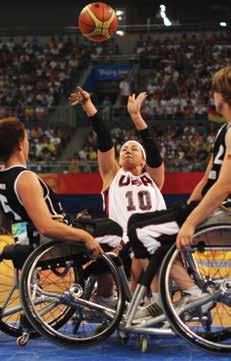
sketch highlighting the careers of its 2017 class describes Wheeler as someone who “has established herself as a mainstay on the U.S. Women’s Wheelchair Basketball team.”
However, before she rose to national and international sports prominence, she faced circumstances that left her with a choice to give up or work hard. When she was a child, an automobile accident left Wheeler paralyzed from the waist down. With characteristic determination, she learned to adjust, going wherever she needed in a wheelchair, and has never slowed down.
Wheeler graduated from Warren County High School and the University of Illinois in Urbana/Champaign, helping the Fighting Illini win three
women’s wheelchair basketball national championships.
She continued to play wheelchair basketball while she pursued a master’s degree in adapted sport education for the University in Alabama, graduating in 2007 with a 4.0 grade point average. While there, Wheeler served as a graduate assistant, teaching activity classes, and as assistant coach of the Crimson Tide women’s wheelchair basketball team.
She returned to her alma mater, Illinois, in 2009 and became head coach of the women’s wheelchair basketball team. Wheeler is currently pursuing a doctoral degree in adapted physical education there.
Wheeler’s determination on the basketball court has led to success at the international level as both a player and coach. She was a member of the United States women’s wheelchair basketball teams who won gold medals at the 2004 and 2008 Paralympic Games.
As head coach of the U.S. women’s wheelchair basketball team, she led her players to the gold medal in the Toronto 2015 Parapan American Games.
Most recently, Wheeler coached Team USA to the gold medal in the 2016 Summer Paralympics in Rio de
Janiero with a victory over defending Paralympics champion Germany. She and the other members of the 2017 Hall of Fame class will be honored during the North Carolina Sports Hall of Fame’s 54th annual induction banquet on May 5 at the Raleigh Convention Center. Wheeler will join 328 previous inductees in the N.C. Sports Hall of Fame, which was established in 1963.
The Bay Area Sports Hall of Fame Enshrinement Banquet on Monday, April 24, 2017 at the Westin St. Francis Hotel in San Francisco
The Bay Area Sports Hall of Fame is proud to announce it has selected the 2017 induction class. The inductees will be honored at the 38th Annual Bay Area Sports Hall of Fame Enshrinement Banquet on Monday, April 24, 2017 at the Westin St. Francis Hotel in San Francisco, Ca.
Each year, the Bay Area Sports Hall of Fame (BASHOF) prepares a ballot and solicits votes from all major media outlets in the Bay Area. There are three ballots: Contemporary (after 1980), Veteran (Prior to 1980) and Distinguished Service. From the re -
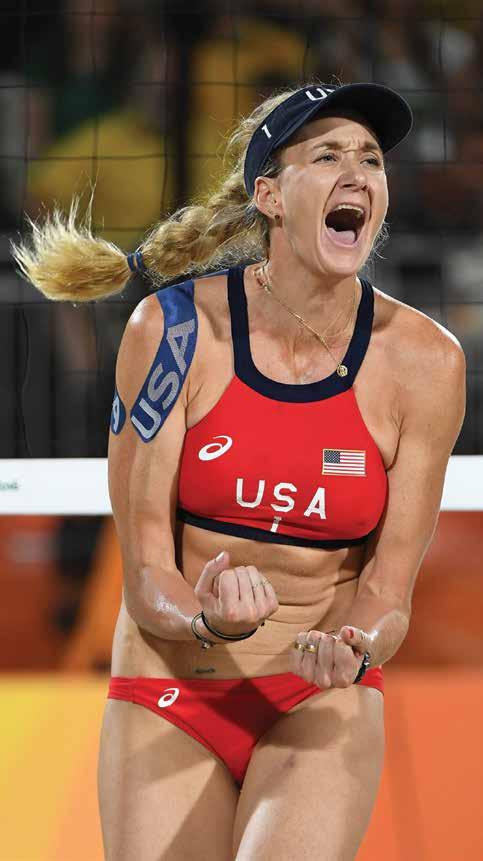
sults of the ballots, 4-5 new inductees are selected annually. Through 2016, there have been 165 persons inducted into the Bay Area Sports Hall of Fame.
We are very honored to present the following inductees for 2017.
Russell Baze (Horse Racing)
Bill Cartwright (Basketball)
Carmen Policy (Distinguished Achievement)
Kerri Walsh Jennings (Volleyball)
Matt Williams (Baseball)
The Bay Area Sports Hall of Fame is a 501(c)(3) non-profit organization that began in 1979 with the San Francisco Chamber of Commerce’s Sports Committee and Lou Spadia, former president of the San Francisco 49ers. Now in its 38th year and adhering to its goal of honoring local athletic legends in the name of benefiting youth sports, BASHOF has donated close to $4 million to youth sports programs in the Bay Area to over 600 youth organizations in the Bay Area.
We are very pleased to continue our tradition with the new 2017 Bay Area Sports Hall of Fame induction class.
The United States Olympic Committee (USOC) has announced the addition of Dr. Cheri Blauwet as an independent member of its board of directors. A three-time Paralympian in track and field, and accomplished medical doctor, Blauwet chairs the International Paralympic Committee (IPC) Medical Committee, serves as a member of the International Olympic Committee Medical and Scientific Expert Group, and until September 2016, served as treasurer on the U.S. Anti-Doping Agency board of directors.
The USOC board of directors also agreed to additional four-year terms for directors Robert Bach, Bill Marolt and Whitney Ping, and elected Larry Probst to a further four-year term as board chair.
“Dr. Blauwet’s achievements on and off the field of play give her a unique perspective on sports governance and we’re pleased to welcome her to the USOC board,” said Probst. “She is extremely well-versed in areas of medicine and the effort to protect clean athletes, and we are confident that she will have an immediate and lasting impact on the USOC and the athletes we serve.”
A seven-time Paralympic medalist, Blauwet joins the USOC board of directors after leading the IPC Medical
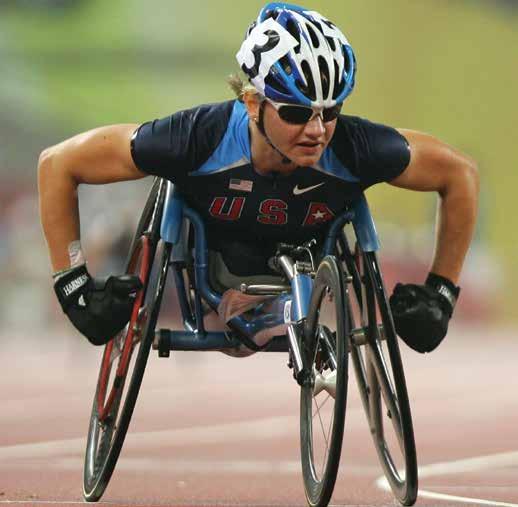
Committee at the Rio 2016 Paralympic Games. With a degree from Stanford Medical School, she maintains an active sports medicine practice at Spaulding Rehabilitation Hospital and the Brigham and Women’s Hospital in Boston, while also serving as an instructor in physical medicine and rehabilitation at Harvard Medical School. She is also a four-time winner of the Los Angeles Marathon and a two-time winner of both the Boston and New York City marathons.
“I am tremendously honored to serve on the USOC board of directors, bring -
ing my background as an athlete and expertise as a physician to the fore, as well as my experience from the Paralympic Movement,” said Blauwet.
“I look forward to serving alongside this tremendous group of professionals to best elevate the success of our country’s Olympic and Paralympic athletes.”
Blauwet fills the seat of outgoing independent director Ursula Burns, who completed her elected term in December 2016.
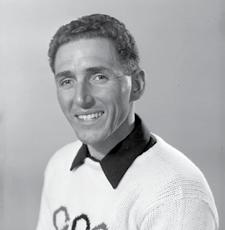

Bill Beck passed away on February 16, 2017 at age 87.
Bill was married for 34 years to Coleen Fitzsimmons, his best friend and business associate, until her untimely death on September 29, 2013. Bill and Coleen enjoyed an exceptional life together with extensive traveling. Whether they were sailing on Lake Champlain, the Caribbean or South Pacific, playing golf or traveling in their motor homes to places unknown, there was always adventures to be had.
Bill graduated from South Kingstown High School in Wakefield, RI and Dartmouth College, class of 1953. He was a former National and North American Downhill Ski Champion and member of the 1952 Men’s Olympic Ski Team, captain of the 1956 Olympic Ski Team, and head men’s coach of the 1960 Olympic Ski Team in Squaw Valley, CA. His 5th place finish in the 1952 Olympic Downhill event in Oslo, Norway was the best American finish in this event until 1984. At the 1980 Winter Olympics in Lake Placid, NY, Bill served as an official in the downhill skiing events.
In 1982, Bill was presented the prestigious Julius Blegen Award by the National Ski Association for his outstanding contribution to the sport of skiing. After his competitive skiing days, he founded, with Olympic teammate Verne Goodwin, the SKIHAUS stores in Middlebury and Rutland and BeckGoodwin, Inc., a sales firm for ski equipment in the eastern half of the U.S. In 1970, they sold Beck-Goodwin, Inc. to the Garcia Corp. with a 5-year contract to manage the ski and hockey division. After leaving the ski equipment business in 1975, Bill opened Bill Beck Real Estate, a residential real estate firm in Middlebury, VT. By 1980 the firm became the largest and most successful in Addison County with offices in Middlebury and Vergennes. Bill retired in 2001.
During his 57 years in Middlebury, Bill was a committed volunteer to various organizations. He served as a Director of the Eastern Ski Association, Director of the Addison County Chamber of Commerce, President of the Middlebury Development Corporation, President of the Addison County Board of Realtors, Vice President of Porter Medical Center, Director of Tucel Industries and the Waterville Company, Director of Addison County Community Housing, and cochair of the 1989 Addison County United Way campaign with his wife Coleen. In September of 1995, Bill and his wife Coleen were presented with the Chamber of Commerce President’s Award for extraordinary service to the Chamber.
daughter-in-law, Jenna, and grandsons Will and Jack of Victor, ID. In addition, Bill will be deeply missed by his brothers and sisters-in-law, Mark and Lisa Quinlan of South Burlington, Mark and Margaret Fitzsimmons of Alexandria, VA, and Bob and Pat Fitzsimmons of East Montpelier.
The family would like to offer countless thanks to the wonderful staff at Eastview at Middlebury for their exemplary care and compassion. Additionally, Bill was so fortunate to have numerous close friends who visited him on a regular basis to reminisce and share a glass of wine. He touched many lives and was certainly loved by all.
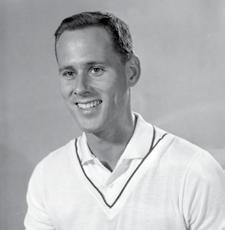
John “Jack” Beckner (Gymnastics, 1952, 1956, 1960, 1968 Coach)
Jack Beckner passed away on November 16, 2016 at age 86.
Bill is survived by his son Billy Beck,
Jack helped the U.S. team finish sixth in 1956 and fifth in 1960. He was the head coach for the 1968 U.S. Olympic team in Mexico City. Beckner also won two NCAA gold medals while at the University of Southern California and went on to coach 16 NCAA Champions at his alma mater. He was the younger brother of
William L. “Bill” Beck (Skiing, 1952, 1956, 1960 Coach)
Dick Beckner, a 1956 Olympian.
Jack won the AAU all-around title from 1956-59, and multiple other apparatus titles and medals. He competed for the Los Angeles Turners, leading them to eight AAU team titles. He starred at the 1955 and 1959 Pan American Games, winning 17 medals and 15 gold medals, including 7 individual gold medals. His 17 Pan Am medals is the second most by any American.
Beckner later judged gymnastics competitions, both in local and national events, as well as internationally. He is a member of the U.S. Gymnastics Hall of Fame, the USC Athletic Hall of Fame, and won the National Judges’ Hall of Fame Cumiskey Award in 1989.
He is survived by his wife Barbara, their three children, John, Michael and Maria, and 10 grandchildren.

William “Billy” Norval Craig (Swimming, 1964)
William “Billy” Craig passed away on January 1, 2017 at age 71.
Billy took to the water as a child when his mother moved into a house with a 20’ x 50’ swimming pool.
He played Little League baseball until high school, but completely shifted his sport after his mother put him in swimming lessons. While he attended Hoover High School in Glendale he was a talented competitive swimmer, making All CIF in his sophomore, junior and senior years, and helping Hoover High swim team win the State Championship. In 1963, he began attending the University of Southern California. He was a member of the Kappa Alpha Order, and at USC he met many of his lifelong friends. He swam on the university swim team, becoming an All-American. He represented the United States at the 1964 Summer Olympics in Tokyo, where he won a gold medal swimming the breaststroke leg for the first-place U.S. team in the men’s 4x100-meter medley relay. Craig and his teammates set a new medley relay world record of 3:58.4. Watching the Olympics swim competition was a great passion for the rest of his life.
He graduated USC in 1967 but his love for his school and the Trojans never waned. He loved football season, often following his team to other states to cheer them on. When they were in town, he celebrated with his fellow Trojan fans by taking a bus to the stadium and spending the day enjoying the game and elaborate tailgate parties. Being a Trojan fan was an art form for Billy and his crowd.
Billy loved Newport Beach, but his true home was Hawaii. He first got a look at Hawaii on his way to the Tokyo Olympics and was forever hooked. He went there as often as he could and his favorite
hangout was the Outrigger Canoe Club in Oahu. This beautiful chain of islands became the inspiration for his restaurant Billy’s at the Beach. He brought a true Hawaiian vibe to Newport Beach with the decor, the art, the food and the music of Hawaii. His daily life consisted of cherished time spent with his family, visiting with customers and friends at his restaurant, and swimming at the Balboa Bay Club, also a lifetime habit. He was easy to recognize in his favorite Outrigger shorts or his classic Hawaiian shirts.
He touched the lives of countless people in the community with his warmth, friendship and generosity. He was a natural leader, a loyal friend, and had a caring, attentive way with anyone he met. He had cool and charisma to spare and a youthful and energetic personality despite his age or health. He was loved by all who knew him and will be deeply missed.
Billy is survived by his loving wife of 17 years, Patty Craig and their son Christian; his son Rick (Kendra), his daughter Kimber, and his grandchildren Taylor and Jordan.
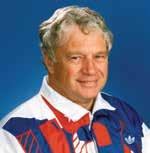

Stanley Huntsman passed away on November 23, 2016, at age 84.
Stanley’s career spanned 39 years and three schools: Ohio University (19561971), where he was promoted to head coach after working as a graduate student assistant; the University of Tennessee (1971-1985); and the University of Texas (1985-1995).
In total, he coached 41 individual national champions and four championship relay teams, and led his teams to 46 conference championships. He was named NCAA national coach of the year six times and inducted into the National Track & Field Hall of Fame in 2004.
While at Tennessee, Stan won the 1972 national cross-country championship and the 1974 national outdoor track and field championship – the school’s first in both sports – and a school record 93 meets and 31 conference titles.
His success in Knoxville led him to Texas, which boasts one of the most prestigious and best funded athletic departments in the country but at the time had struggled to find success on
the track. Stan transformed the program into a perennial contender, dethroning Southwest Conference powerhouse Arkansas in his first year and twice finishing as a national runner-up in outdoor track.
It was while coaching at Texas that Huntsman was selected to lead the U.S. men’s track and field team at the 1988 Games in Seoul. The team led the world with seven gold medals.
In addition to the 1988 Olympics, Stan served as an assistant coach at the 1976 Games in Montreal and was named as an assistant coach for the 1980 Olympic Games. He also served as U.S. head coach for three IAAF competitions; 1977 World Cup, 1983 World Championships and 2003 World Indoor Championships.
Stan is survived by his wife of 52 years, Sylvia Scalzi Huntsman; son, Stanley Stephen of Los Angeles, CA; daughter, Coni Huntsman Stogner, son-in-law Bradley Stogner and their children, Connor, Mackenzie and Quentin of Austin, Texas.

Robert Lee “Bob” James, Jr. (Sailing, 1968)
Robert James, Jr. passed away on December 13, 2016 at age 83.
Bob James was both driven and adventurous. At the age of 16 he sparked an interest in flying and used his savings from odd jobs to purchase his own private airplane; a Piper J-3 Cub. When he graduated from Mathews High School his aspirations landed him at Georgia Institute of Technology. In 1955 he graduated from GA Tech as a loyal Yellow Jacket and as a member of Phi Beta Kappa with a B.S. degree in aeronautical engineering.
Bob’s career honored his passion for adventure and flight. He was first employed by the Martin Company where he was hired to develop missile technology. In 1959 he became one of the early pioneers of space exploration by taking a position at NASA Langley Research Center. During his almost 30year career as an aerospace engineer at NASA he worked on countless projects on the forefront of spaceflight and aircraft design; most notably Skylab, Nimbus G, and LDEF (Long Duration Exposure Facility).
In 1988 Bob retired from NASA to enjoy
Stanley “Stan” Huntsman (Track & Field Coach, 1988)
sailing, fishing, hunting, tennis, and golf. Coming from a family of mariners, Bob’s life was highly influenced by nature and the sea. He was a self-taught sailor who learned by sailing small dinghies in the Mobjack Bay and surrounding rivers. In his late 20s and 30s his adventurous and competitive spirit propelled him into international sailing competitions. The pinnacle of his sailing career was competing in the 1968 Olympic Games in Mexico City with his brother David where they raced the Flying Dutchman.
In 1972 Bob and several close friends founded the Ware River Yacht Club. He was a dedicated member of the WRYC community and served as Commodore and Race Committee Chairman on and off for many years. It was there where he could channel his passion for sailing into helping local youth learn the sport.
Bob’s biggest legacy is the love and appreciation of the water and the outdoors that he has bestowed upon his children and grandchildren. He relished sharing his knowledge about the Chesapeake Bay, its tributaries and the sustenance it provides. He took every opportunity to teach his family everything he knew about the rivers and the Bay, about the wind patterns, and the mystery of the tides. He understood and appreciated the course of life and the role that nature plays in it. The moments where we learned from him will be the ones we miss the most.
Bob is preceded in death by his parents; Robert Lee James, Sr. and Katherine Oliver James and his youngest sister Carolyn Elizabeth James. He is survived
by a large loving family including his wife of 33 years, June Mitchell James; his sister Mary Katherine Mason; his brother, David Nowell James; his children, Robert Lee James III, Scott Culp James and his wife Susan, Clayton Wellington James and his wife Ginger, and Elizabeth James Longest and husband Greg. He is also survived by four grandchildren, Kathryn and Drake James and Blake and Caroline Longest as well as his loving and devoted black Labrador retriever named Katie.
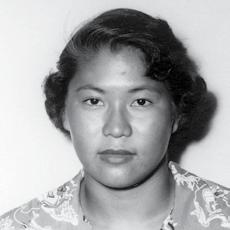
Evelyn Kawamoto-Konno (Swimming, 1952)
Evelyn Kawamoto-Konno passed away on January 22, 2017 at age 83.
Evelyn Kawamoto-Konno was swimming seven days a week and breaking local records at McKinley High School by the age of 13.
Kawamoto-Konno competed in the 1948 Olympic Trials at the age of 14. In 1949, she broke the American record in the women’s 300-meter Individual Medley (IM) and the 200-meter breaststroke on the same day. A month later, she won both events at the U.S. Nationals. On the final day of the 1952 U.S. Women’s Olympic Trials, she set the American
record in the 400-meter freestyle.
Evelyn represented the United States at the 1952 Summer Olympic Games in Helsinki, where she earned two bronze medals as an 18-year-old. She received her first bronze in the women’s 4×100-meter freestyle relay. Individually, she set an Olympic record in the 400-meter freestyle in a preliminary heat and received a second bronze for her third place performance in the women’s 400-meter freestyle.
She later married U.S. Olympic swimming gold medalist Ford Konno, who also competed at the 1952 Summer Olympics. Kawamoto-Konno was inducted into the Hawaii Sports Hall of Fame in 2000.
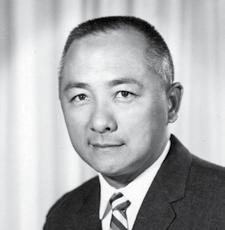
Sammy Lee
(Diving, 1948, 1952, 1960 Coach)
Sammy Lee passed away on December 2, 2016 at age 96.
Sammy won gold medals in platform diving in the 1948 and 1952 Olympic Games. He was the first diver to repeat platform gold, and at 32 years of age in 1952, the oldest up to that date. He was also the first Asian-American to win a gold medal for the U.S. He also
earned a bronze medal in the 3-meter springboard event in 1948.
He was inspired by the 1932 Olympics in Los Angeles to become a diver. By 1942, he was the AAU national champion in platform and springboard diving, becoming the first person of color to win that title.
After his own diving career ended, he coached the U.S. Olympic team in 1960. He coached Olympic champions Pat McCormick, Bob Webster, and four-time champion Greg Louganis.
He was inducted into the International Swimming Hall of Fame in 1968 and the U.S. Olympic Hall of Fame in 1990.
Apart from athletics, he earned a medical degree from the University of Southern California School of Medicine in 1947. He was an ear, nose, and throat specialist. He also served in the U.S. Army for 13 years, retiring with the rank of major.
In 2010, Sammy Lee Square was dedicated to him in the Koreatown neighborhood of Los Angeles. In 2013, a Los Angeles elementary school was named the Sammy Lee Medical and Health Science Magnet School in his honor.
“Through his multitude of achievements and awards, (my father) treasured his family most,” his son, Sammy II, told the Orange County Register. “He often stated, ‘The medals fade but my wife, daughter, son, and grandchildren
become more golden and precious during the last two-minute drill of my game.’”
Lee is survived by wife Roz, children Pamela and Sammy II, and three grandchildren.


Theresa Manuel passed away on November 21, 2016 at age 90.
Theresa competed at the 1948 Olympic Games in London, she later motivated students “to win on the field and in life.”
Manuel played basketball at Tuskegee Institute (now University) in Alabama, earning the nickname “Trick Shot.” Seeing her run, college teammates urged her to go out for track. She excelled, setting a record for the 50-meter hurdles on a dirt track. While she was at Tuskegee the women’s teams were undefeated in both basketball and track. That led her to joining the Olympic Team, where she competed in the 80-meter hurdles, threw the javelin and ran the third leg in the 440-yard relay.
The year after the Olympics, Theresa graduated from Tuskegee. She turned
down at least one marriage proposal so she could return to Tampa to care for her ailing mother and teach at her alma mater.
She was a long time teacher and coach at Middleton and Hillsborough High Schools. She coached basketball, swimming, majorettes and dancerettes before retiring in 1988. She was named Hillsborough County Coach of the Year in girls’ basketball in 1975 and Florida Coach of the Year in 1976.
While she was best known as an athlete, Theresa showed early on that she was undaunted in the face of racial barriers. “We went to a store when I was a teenager and there were two water fountains, one white and one colored, and I wanted to taste the water from the white one to see if it tasted the same,” she once recalled.
She turned to a friend and offered two words of advice that were good for that moment – and the rest of her life. “Watch me.”
Theresa A. Manuel (Track & Field, 1948)

Tom Neely passed away on January 14, 2017 at age 78.
Tom passed away at his Ketchum home in his sleep. His death came as a complete surprise to his friends because of his apparent good health and his enjoyment of retirement.
Tom was a member of the 1964 Winter Olympic Team in Innsbruck, Austria during the first outing of Luge as an Olympic sport.
Tom was retired from a lifetime of labor of love as a ski instructor, tennis pro, bike shop owner and manager of the Sun Valley Gun Club. Along the way, he found time to work at the original Scott USA ski pole plant in Ketchum, waited tables at the Wood River Yacht Club and spent a couple of years in the deserts of Saudi Arabia running recreation programs for contractors building the King Khalid Military City in the years before the first Gulf War.
Tom was a skilled athlete, but he was especially adept at getting others to learn a skill they did not know they had.
Tom was born May 15, 1938 to a military family in Fort Sill, Oklahoma. He attended American University and George Washington University in Washington, DC and the University of Maryland campus in Munich, Germany. He enlisted in the U.S. Army in Nov, 1961 and was assigned to an armored unit in Germany. It was there that he learned of the huge sports programs that the military fostered and encouraged. On one of many try-outs for different sports, he was introduced to the Luge in 196263 and became a member of what would become the Luge team. That lead to intense training and competitions in both the eastern and western block countries and eventually to Innsbruck and the 1964 Winter Olympics. The Luge team in 1964 was a mix of military and civilians that trained out of Armed Forces Recreation Center (AFRC) facilities in Garmisch and Berchtesgaden, Germany.
Tom was honorably discharged from the Army in 1964 after the Winter Olympics. This was about the same time that the Janss Corp. purchased Sun Valley from Union Pacific. Tom soon found his way to Ketchum/Sun Valley and it would remain his home for the rest of his life. He was soon followed by the entire Neely clan. Tom was married to Michele Urbany Neely in December, 1974 in Ketchum. Idaho. They were later divorced but remained close friends.
He was pre-deceased by his father, Brigadier General Robert Benton Neely, USA Retired, younger brother, John Meehan Neely, and his mother, Kenneth Rosemary “Posey” Kendall Neely.
In lieu of flowers, please hit a ball, shoot a round, ski a rundown Baldy, drink a Shandy at the Pioneer Saloon and remember the good times.

(Paralympic Sled Hockey Coach, 2010, 2014)
Jeff Sauer passed away on February 2, 2017 at age 73.
Jeff accepted an athletic scholarship from Colorado College and began attending the school in 1961. After sitting out the Tigers’ disastrous 0-23 season in 1961-62 Sauer became part of the rebuild under first Tony Frasca and then Bob Johnson. Despite his efforts, Sauer couldn’t help Colorado College reach the WCHA playoffs in any of his three seasons before graduating in 1965. After graduating Sauer signed on as an assistant under Johnson at CC and then followed his former coach to Wisconsin, staying with the program until just after the Badgers joined the WCHA before he received his shot behind the bench at his alma mater. Sauer took over for a rather moribund program that had seen only two winning seasons in their past 13 campaigns and slowly brought the team
Tom Neely ( Luge, 1964)
back to respectability. It took Sauer four years to build a winning team, finishing 1974-75 in 3rd place. His biggest achievement came three years later when the 5th-place Tigers upset a 33win Denver team to capture a share of the WCHA tournament, the only conference tournament title in team history. All told, however, Sauer didn’t have much more success than his predecessors as he could only provide Colorado College with two winning seasons in 11 years as head coach.
When his former boss Johnson left Wisconsin after 1981–82 to pursue an NHL coaching career, Sauer returned to Madison to replace him and immediately found the success that had eluded him at Colorado College when the Badgers won the national title in 1983. Throughout the 1980s Wisconsin remained one of the top programs in the country, routinely winning 20 games a year. In 1990 Sauer proved that not only could he coach a national champion, but he could build one as well when he captured his second NCAA title. In Sauer’s 20 seasons with Wisconsin he provided two conference regular season titles, five conference tournament titles, four 30-win seasons and 11 NCAA tournament berths in addition to winning two national titles. He retired as head coach after the 2001–02 season, turning the program over to Badger alumnus Mike Eaves.
After stepping down Sauer agreed to serve as the assistant commissioner for the WCHA for several years and in 2010
he returned as head coach for the U.S. sled hockey team at the 2010 Paralympic Winter Games. He helped the Americans to their second gold medal in the event and four years later returned for a repeat performance in Sochi.

Judith “Judy” Roberts Thomas passed away on November 22, 2016 at age 82.
Judy graduated from Indiana University in 1956 where she was a member of Kappa Kappa Gamma Sorority. She met her husband, Morris (Mo) Thomas, Jr. at IU and they were married after graduation in 1956. They enjoyed 60 years of happy marriage.
Judy was an outstanding swimmer and was a member of the United States Olympic Swim team. She competed in the 1952 Olympic Games in Helsinki, Finland. She represented the United States in the Pan American Games in Mexico City in 1955 and won a gold medal. She also won multiple National Championships.
Judy had many interests. She was a member of Meridian Street United Methodist Church for years and she and Mo were involved with the Church’s 5th and 6th Grade summer camps at Camp Otto. She co-chaired the Church’s Annual Flower Festival. She loved the Children’s Museum and was an active member of its Guild. Judy was passionate about the Indiana United Methodist Children’s Home and its work with kids, where she served for many years as a member of its Board of trustees. Judy was an active member or Meridian Hills Country Club where she enjoyed golf and bridge with her friends. Judy was also a member of the Bridgewater Club.
Judy is survived by her husband Mo, her daughter, Terri Thomas and son James (Katie) Thomas. Her grandchildren are Judy (“Little Judy”), Madeline and Jacob. Her brothers, Richard and Ron, and her sister, Connie, predeceased her.

Join our private groups on Facebook and Linked In to stay connected.
FACEBOOK: United States Olympians and Paralympians (971 members)
LINKED IN: United States Olympians and Paralympians (364 members)
Olympic and Paralympic Alumni (12,876 members international)
CONNECT WITH LA 2024:
Youtube: https://www. youtube.com/channel/UC0HoUCfNT_13tkuxvtdnyA
Instagram: https://www. instagram.com/la2024/
Twitter: https://twitter.com/ LA2024
Facebook: https://www. facebook.com/la2024


1. Olympians and Pac-12 administrators are honored during halftime at the 2017 Pac-12 Men’s Basketball Championships on March 10, 2017 in Las Vegas. Photo credit: Douglas Taylor Photography
2. Herb Douglas (track & field, 1948) and John Carlos (track & field, 1968) attend an event hosted by The Cleveland Cavaliers to honor NFL’s greatest running back, Jim Brown. Jim was the recipient of the 2017 Cleveland Cavaliers Heritage Award.
L to R: Rodney Williams (Chief Market Officer, Executive Vice President, Moët Hennessy USA), Herb Douglas, Jim Brown, John Carlos
3.—7. #TeamUSA Today
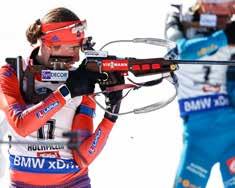


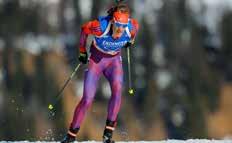

Art of the Olympians (AOTO), an international group of 50 Olympian and Paralympian artists from 18 countries, is continuing to expand and looking for new artists. AOTO , founded by Al Oerter in 2006, has launched a global campaign to find Olympians and Paralympians that have a creative side and are involved in the Arts. We are looking for painters, sculptors, photographers, graphic designers, fashion designers, writers, poets, actors, directors, producers, video/film makers, musicians, dancers, singers, etc.
Contact information:
Website: http://artoftheolympians.org/
Email: info@artoftheolympians
Phone: +1 770 882 7799
PRESIDENT
Dick Fosbury, (Track & Field, 1968)
Contact: fosbury@cox-internet.com
VICE PRESIDENTS
Allison Baver (Speed Skating, 2002, 2006, 2010)
Contact: allison@allisonbaver.com
Carol Brown (Rowing, 1976, 1980, 1984)
Contact: carolpb@msn.com
Candace Cable (Paralympic Track and Field; 1980, 1988, 1992, 1996/Alpine Skiing; 1992/Nordic Skiing; 1994, 1998, 2002, 2006)
Contact: candace@candacecable.com
Caryn Davies (Rowing, 2004, 2008, 2012)
Contact: caryn.davies@gmail.com
Micki J. King (Diving, 1968, 1972)
Contact: micki.king172@gmail.com
Carol Lewis (Track & Field, 1980, 1984, 1988)
Contact: misscarol63@gmail.com
Iris T. Zimmermann (Fencing, 2000)
Contact: zimmermann.iris@gmail.com
Gary Hall, Sr. (Swimming, 1968, 1972, 1976)
Contact: garyhallsr@mac.com
Willie Banks (Track & Field, 1980, 1984, 1988)
Contact: bankshw@hotmail.com
John Naber (Swimming, 1976)
Contact: john@johnnaber.com
Bill Toomey (Track & Field, 1968)
Contact: williamtoomey@gmail.com
DIRECTORS
USOC CHAIRMAN
Larry Probst
Robert Bach
James Benson
Scott A. Blackmun
Cheri Blauwet
Anita L. DeFrantz (rowing, 1976, 1980)
Daniel Doctoroff
Nina Kemppel (cross-country skiing, 1992, 1994, 1998, 2002)
Susanne Lyons
Bill Marolt (alpine skiing, 1964)
Steve Mesler (bosbled, 2002, 2006, 2010)
Dave Ogrean
Whitney Ping (table tennis, 2004)
Angela Ruggiero (ice hockey,1998, 2002, 2006, 2010)
Kevin White
Bob Wood
USOC CHIEF EXECUTIVE OFFICER
Scott A. Blackmun
EDITORIAL STAFF
SENIOR EDITOR
Cynthia E. Stinger (team handball, 1984, 1988, 1992)
ASSOCIATE EDITOR
Christine Taylor
PRODUCTION DIRECTOR
O’Shea Design
Alabama Olympians & Paralympians
President: Jennifer Chandler Stevenson (diving, 1976) (205) 313-7436
Arizona Olympians & Paralympians
President: Misty Hyman (swimming, 2000) (650) 248-6359
Austin-San Antonio Olympians & Paralympians
President: Randy Lipscher (field hockey, 1984) (505) 453-6160
Colorado Olympians & Paralympians
President: Michelle Dusserre Farrell (gymnastics, 1984) (719) 330-4030
Dallas/Fort Worth Olympians & Paralympians
President: Sammy Walker (weightlifting, 1976) (469) 955-3158
Florida Olympians & Paralympians
President: Carrie Zimmerman (gymnastics, 1976) (850) 212-7846
Georgia Olympians & Paralympians
President: Bob Pickens (wrestling, 1964) (773) 425-3254
Hawaii Olympians & Paralympians
President: Brent Berk (swimming, 1968) (808) 395-0600
Houston Olympians & Paralympians
President: Jacqueline Washington (track & field, 1984) (832) 488-8573
Idaho Olympians & Paralympians
President: Dick Fosbury (track & field, 1968) (208) 720-2352
Indiana Olympians & Paralympians
President: Ollan Cassell (track & field, 1964) (317) 253-1162
Louisiana Olympians & Paralympians
President: Hollis Conway (track & field, 1988, 1992) (318) 237-2382
Michigan Olympians & Paralympians
President: Gary F. Morgan (track & field, 1988) (248) 396-4936
Midwest Olympians & Paralympians
President: Diane Simpson (rhythmic gymnastics, 1988) (847) 452-7843
Minnesota Olympians & Paralympians
President: Katrina Radke (swimming, 1988) (651) 335-3647
Missouri/Illinois Olympians & Paralympians
President: John Carenza (soccer, 1972) (314) 662-4990
National Capital Area Olympians & Paralympians
President: Arlene Limas (taekwondo, 1988) (540) 720-1988
Nevada Olympians & Paralympians
President: Dean Willeford (water polo, 1968) (775) 827-1775
New England Area Olympians & Paralympians
President: Sharon Ann Jewell (taekwondo, 1988) (404) 668-7896
New Mexico Olympians & Paralympians
President: Trish K. Porter Topmiller (track & field, 1988) (505) 459-9732
Northern California Olympians & Paralympians
President: Greg Massialas (fencing, 1980, 1984, 1988) (415) 441-0521
Oklahoma Olympians & Paralympians
President: Josh C. Davis (swimming, 1996, 2000) (210) 889-7667
Oregon Olympians & Paralympians
President: David Johnson (track & field, 1988, 1992) (503) 302-3992
San Diego Olympians & Paralympians
President: Erin Aldrich-Shean (track & field, 2000) (214) 725-9926
Southern California Olympians & Paralympians
President: Tamara Jenkins (canoe/kayak, 2000) (424) 443-9030
Tri-States Olympians & Paralympians
President: Diane Dixon (track & field, 1984, 1988) (917) 538-3195
Utah Olympians & Paralympians
President: Debra Stark (gymnastics, 1972) (801) 369-9918
Washington Olympians & Paralympians
President: Charles Ruthford (rowing, 1972) (206) 819-3559
Western PA-OH-WV Olympians & Paralympians
President: Julie Koons (speedskating, 2002) (216) 346-2650
No chapter in your area?
Interested in starting a chapter?
Contact the U.S. Olympians & Paralympians Association office for details at: (800) 717-7555
www.teamusa.org